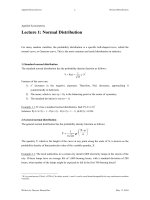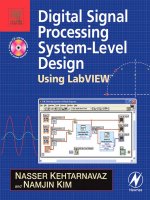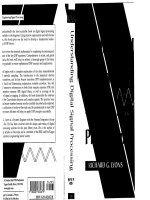Lecture 1: Discrete Time Signal Processing
Bạn đang xem bản rút gọn của tài liệu. Xem và tải ngay bản đầy đủ của tài liệu tại đây (223.44 KB, 48 trang )
Discrete Time Signal
Processing
Chu-Song Chen (陳祝嵩)
Institute of Information Science
Academia Sinica
中央研究院 資訊科學研究所
Textbook
Main Textbook
Alan V. Oppenheim and Ronald W.
Schafer, Discrete-Time Signal
Processing, Second Edition, PrenticeHall, 1999. (全華代理)
Reference
James. H. McClellan, Ronald W. Schafer,
and Mark. A. Yoder, Signal Processing First,
Prentice Hall, 2004. (開發代理)
Activities
Homework – about three times.
Tests: twice
First test: October 17
Second test: to be announced
Term project
Teach Assistant
鄭文皇
通訊與多媒體實驗室
/>
Contents
Discrete-time signals and systems
The z-transform
Sample of continuous-time signals
Transform analysis of linear time
invariant systems
Structure for discrete-time systems
Contents (continue)
Filter design techniques
The discrete Fourier transform
Computation of the discrete Fourier
transform
Fourier analysis of signals using the
discrete Fourier transform
Signals
Something that conveys information
Generally convey information about the
state or behavior of a physical system.
Signal representation
represented mathematically as functions of
one or more independent variables.
Signal Examples
Speech signal: represented as a
function over time. -- 1D signal
Image signal: represented as a
brightness function of two spatial
variables. -- 2D signal
Ultra sound data or image sequence –
3D signal
Signal Types
Continuous-time signal
defined along a continuum of times and thus
are represented by a continuous independent
variable.
also referred to as analog signal
Discrete-time signal
defined at discrete times, and thus, the
independent variable has discrete values:
i.e., a discrete-time signal is represented as a
sequence of numbers
Signal Types (continue)
Digital Signals
those for which both time and amplitude are discrete
Signal Processing System: map an input signal to
an output signal
Continuous-time systems
Discrete-time system
Systems for which both input and output are continuous-time
signals
Both input and output are discrete-time signals
Digital system
Both input and output are digital signals
Example of Discrete-time
Signal
Discrete-time signal
Discrete-time Signal
x = {x[n]}, -∞ < n < ∞
where n is an integer
Generation of Discrete-time
Signal
In practice, such sequences can
often arise from periodic
sampling of an analog signal.
x = xa [nT ], -∞ < n < ∞
Signal Operations
Multiplication and addition
The product and sum of two sequences x[n] and
y[n] are defined as the sample-by-sample product
and sum, respectively.
Multiplication by a number a is defined as
multiplication of each sample value by a.
Shift operation: y[n] is a delayed or shifted
version of x[n]
y[n] = x[n − n0 ]
where n0 is an integer.
A Particular Signal
Unit sample sequence
Unit impulse function, Dirac delta function, impulse
⎧0 n ≠ 0
δ [n] = ⎨
⎩1 n = 0
Signal Representation
An arbitrary sequence can be represented as a
sum of scaled, delayed impulses.
x[n] =
∞
∑ x[k ]δ [n − k ]
k = −∞
Some Signal Examples
Unit step sequence
⎧1 n ≥ 0
u[n] = ⎨
⎩0 n < 0
Some Signal Examples (cont.)
Real exponential sequence
⎧ Aα n
y[n] = ⎨
⎩ 0
n≥0
n<0
x[n] = Aα
n
y[n] can be represented as
y[n] = Aα nu[n]
Some Signal Examples (cont.)
Sinusoidal sequence
x[n] = A cos(w0 n + φ )
Complex Exponential Sequence
Consider an exponential sequence x[n] = Aαn,
where α is a complex number having real and
imaginary parts
x[n] = Aα = A e α e j (w0 n )
n
= Aα e
n
j ( w0 n +φ )
jφ
n
= Aα (cos(w0 n + φ ) + j sin(w0 n + φ ))
n
The sequence oscillates with an exponentialy
growing envelope if |α|>1, or with an
exponentially decaying envelope if |α|<1
Complex Exponential Sequence
(cont.)
If α =1, the resulted sequence is referred to as
a complex exponential sequence and has the
form
x[n] = A e
j ( w0 n +φ )
= A (cos(w0 n + φ ) + j sin(w0 n + φ ))
The real and imaginary parts of e j (w0 n +φ ) vary
sinusoidally with n.
w0 is called the frequency of the complex
exponential and φ is called the phase.
Discrete and Continuous-time
Complex Exponential: Differences
We only need to consider frequencies in an
interval of length 2π, such as -π
x[n] = A e
j ( w0 n +φ )
= Ae
j ( w0 n +φ + 2πn )
= Ae
j (( w0 + 2π )n +φ )
This property holds also for discrete sinusodial
signals: (r is an integer)
x[n] = A cos(w0 n + φ ) = A cos((w0 + 2πr )n + φ )
This property does not hold for continuoustime complex exponential signals.
Another Difference
In a continuous-time signal, both complex
exponentials and sinusoids are periodic: the period
is equal to 2π divided by the frequency.
In the discrete-time case, a periodic sequence
shall satisfy x[n] = x[n+N], for all n.
e
jw0 ( n + N )
=e
jw0 n
So, if a discrete-time complex exponential is
periodical, then w0N = 2πk shall be hold.
Example
Consider a signal x1[n] = cos(πn/4), the signal has a
period of N=8.
Let x2[n] = cos(3πn/8), which has a higher frequency
than x1[n] but x2[n] is not periodic with period 8,
but has a period of N=16.
Contrary to our intuition from continuous-time sinusoids,
increasing the frequency of a discrete-time sinusoid
does not necessarily decrease the period of the signal.
Denote x3[n] = cos(n), there exists no integer N
satisfying that x3[n+N] = x3[n].
Example (continue)
(a) w0 = 0 or 2π
(b) w0 = π/8 or
15π/8
(c) w0 = π/4 or
7π/4
(d) w0 = π
As w0 increases from
zero toward π (parts ad) the sequence
oscillates more rapidly.
As w0 increases from π
toward 2π (parts d-a),
the sequence
oscillation become
slower.
Discrete-time Systems
A transformation or operator that maps an input
sequence with values x[n] into an output sequence
with value y[n] .
y[n] = T{x[n]}
x[n]
T{⋅}
y[n]









